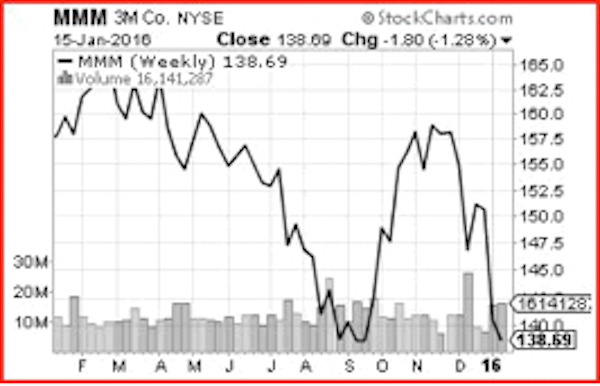Keeping Your Head in a Plummeting Market
The six-year bull market was great. Now that a bear looms, it will be the buyers who end up making the big money. Here’s why I like 3M Company.

The way the year has begun in the stock market, you'd think the world was coming to an end. On a percentage basis, the first two weeks of trading were the worst ever for the Dow Jones Industrial Average. The price of crude oil has plunged below $30 per barrel, and there is no shortage of speculation about the imminent collapse of one company or another. Every gloomy headline feeds the selling frenzy.
There’s no doubt that a bear market (defined as a market decline of 20% or more) is a growing possibility. But bear markets have raged many times in the past. Indeed, the one thing that all bear markets have in common is that they come to an end.
So the question you must address is whether it is wise to sell the stock of companies that until recently you have been happy to own. You might ask yourself whether you would be selling simply because other people are doing so? To paraphrase Rudyard Kipling, by way of Warren Buffett, the successful investor is the one who can keep his head while all about him are losing theirs. Corporate profits tend to fluctuate and can be under pressure from temporary situations—even just the emotional responses of shareholders to issues that are beyond the control of the company.
From just $107.88 $24.99 for Kiplinger Personal Finance
Become a smarter, better informed investor. Subscribe from just $107.88 $24.99, plus get up to 4 Special Issues

Sign up for Kiplinger’s Free Newsletters
Profit and prosper with the best of expert advice on investing, taxes, retirement, personal finance and more - straight to your e-mail.
Profit and prosper with the best of expert advice - straight to your e-mail.
We’ve all enjoyed the bull market that has expanded over the past six years. But, still, it pays to recognize that it has to rain at some point. It’s vital for the process. But that’s not how people react. Based on the response of stock market participants, you might believe that the sight of dark clouds portends the end of the world. When the pessimists take over, the stock market generally spirals downward. But it’s the optimists who end up making the big money. These are the people who are buying when everyone is selling.
That’s not an easy thing to do! And that’s why dollar-cost averaging (and dividend reinvesting) is such an important strategy during turbulent markets. Even if you don’t possess a cool head, this strategy will help you overcome your tendency to overreact to short-term market conditions so you can take advantage of the opportunity provided by those who do.
As an investor, you have to find a way to overcome your natural reaction to overreact to the noise—regardless of whether it is optimistic or negative. The objective is to build wealth by logical purchases of high-quality companies at relatively good prices. Dollar-cost averaging does just that.
Every two weeks, we select a company that we believe is appropriate for your core holdings. We do not consider the market price of the stock when we make these selections. That’s because we anticipate that the reader will build up holdings in these companies by investing a small or large amount on a regular basis through the company dividend reinvestment plan (DRIP).
We recommend the enrollment service of our affiliate company, Temper of the Times Investor Services, as a means to become enrolled in the DRIP of this company or any other of about 1,000 companies that offer the opportunity to invest directly—thereby bypassing brokers.
Our current recommendation is 3M Company (MMM). Founded in 1902 as Minnesota Mining & Manufacturing Company, 3M has grown into a $85-billion market cap manufacturer that sells more than 50,000 products around the world, with more than 60% of sales from foreign sources. It operates in five industry segments: Industrial (abrasives, adhesives, sealants, filtration products); Health Care (medical and surgical supplies, dental and food safety products, drug delivery and health information systems); Safety & Graphics (traffic safety and security products, commercial graphics, cleaning, and protection systems, flooring and roofing products); Consumer (home care, improvement, and protection products, office tapes, pads, and note products, cleaning supplies); and Electronics & Energy (touch screens, connection devices, optical films, packaging, insulating, and renewable energy products).
Best known for its Post-It Notes and Scotch tape, 3M now makes everything from dental products and bandages to touch-screen monitors, asphalt shingles, and air conditioner filters. According to Yahoo! Finance, the consensus of 16 analysts called for 3M to earn about $7.55 per share in 2015 and $8.23 in 2016, compared with $7.49 in 2014, when annual sales topped $31 billion. The $4.10-per-share dividend, which provides a 2.9% yield, has been increased for 57 consecutive years, and is expected to be raised with the next payment in February.

What makes 3M so attractive is its scope and resources, which contribute to its proven ability to thrive in virtually any economic environment. Throughout its history, the company has prospered by constantly developing new products, both for consumers and commercial customers, with the result that it has been able to expand both here and abroad. In doing so, 3M has established itself as one of the most widely recognized (and trusted) brand names in the world, and by constantly expanding its product lines in all industries, has become a supplier of countless basic necessities.
As an investment, its stock has benefited by establishing a top-notch balance sheet and enviable history of growing sales, earnings, and dividends; yet the share price is not overvalued, trading at less than 17 times year-ahead earnings per share. The stock is down from a 52-week high of $170, compared with a low of $134.
3M Company is one of many top U.S. companies whose shares you can purchase directly—and commission-free—through their company-sponsored DRIP. These companies actually pay the investing fees for you once you’ve enrolled in their DRIP—and you can enroll with the purchase of just one share in most cases. For our complete list of companies that offer a no-fee DRIP, click here.
Ms. Vita Nelson is one of the earliest proponents of dividend reinvestment plans (DRIPs) and a knowledgeable authority on the operations of these plans. She provides financial information centered around DRIP investing at www.drp.com and www.directinvesting.com. She is the Editor and Publisher of Moneypaper's Guide to Direct Investment Plans, Chairman of the Board of Temper of the Times Investor Service, Inc. (a DRIP enrollment service), and co-manager of the MP 63 Fund (DRIPX).
Profit and prosper with the best of Kiplinger's advice on investing, taxes, retirement, personal finance and much more. Delivered daily. Enter your email in the box and click Sign Me Up.

-
 Nasdaq Sinks 418 Points as Tech Chills: Stock Market Today
Nasdaq Sinks 418 Points as Tech Chills: Stock Market TodayInvestors, traders and speculators are growing cooler to the AI revolution as winter approaches.
-
 23 Last-Minute Gifts That Still Arrive Before Christmas
23 Last-Minute Gifts That Still Arrive Before ChristmasScrambling to cross those last few names off your list? Here are 23 last-minute gifts that you can still get in time for Christmas.
-
 The Rule of Compounding: Why Time Is an Investor's Best Friend
The Rule of Compounding: Why Time Is an Investor's Best FriendDescribed as both a "miracle" and a "wonder," compound interest is simply a function of time.
-
 If You're a U.S. Retiree Living in Portugal, Your Tax Plan Needs a Post-NHR Strategy ASAP
If You're a U.S. Retiree Living in Portugal, Your Tax Plan Needs a Post-NHR Strategy ASAPWhen your 10-year Non-Habitual Resident tax break ends, you could see your tax rate soar. Take steps to plan for this change well before the NHR window closes.
-
 Your Year-End Tax and Estate Planning Review Just Got Urgent
Your Year-End Tax and Estate Planning Review Just Got UrgentChanging tax rules and falling interest rates mean financial planning is more important than ever as 2025 ends. There's still time to make these five key moves.
-
 What Makes This Business So Successful? We Find Out From the Founder's Kids
What Makes This Business So Successful? We Find Out From the Founder's KidsThe children of Morgan Clayton share how their father's wisdom, life experience and caring nature have turned their family business into a respected powerhouse.
-
 Past Performance Is Not Indicative of Your Financial Adviser's Expertise
Past Performance Is Not Indicative of Your Financial Adviser's ExpertiseMany people find a financial adviser by searching online or asking for referrals from friends or family. This can actually end up costing you big-time.
-
 I'm a Financial Planner: If You're Not Doing Roth Conversions, You Need to Read This
I'm a Financial Planner: If You're Not Doing Roth Conversions, You Need to Read ThisRoth conversions and other Roth strategies can be complex, but don't dismiss these tax planning tools outright. They could really work for you and your heirs.
-
 Could Traditional Retirement Expectations Be Killing Us? A Retirement Psychologist Makes the Case
Could Traditional Retirement Expectations Be Killing Us? A Retirement Psychologist Makes the CaseA retirement psychologist makes the case: A fulfilling retirement begins with a blueprint for living, rather than simply the accumulation of a large nest egg.
-
 I'm a Financial Adviser: This Is How You Can Adapt to Social Security Uncertainty
I'm a Financial Adviser: This Is How You Can Adapt to Social Security UncertaintyRather than letting the unknowns make you anxious, focus on building a flexible income strategy that can adapt to possible future Social Security changes.
-
 I'm a Financial Planner for Millionaires: Here's How to Give Your Kids Cash Gifts Without Triggering IRS Paperwork
I'm a Financial Planner for Millionaires: Here's How to Give Your Kids Cash Gifts Without Triggering IRS PaperworkMost people can gift large sums without paying tax or filing a return, especially by structuring gifts across two tax years or splitting gifts with a spouse.